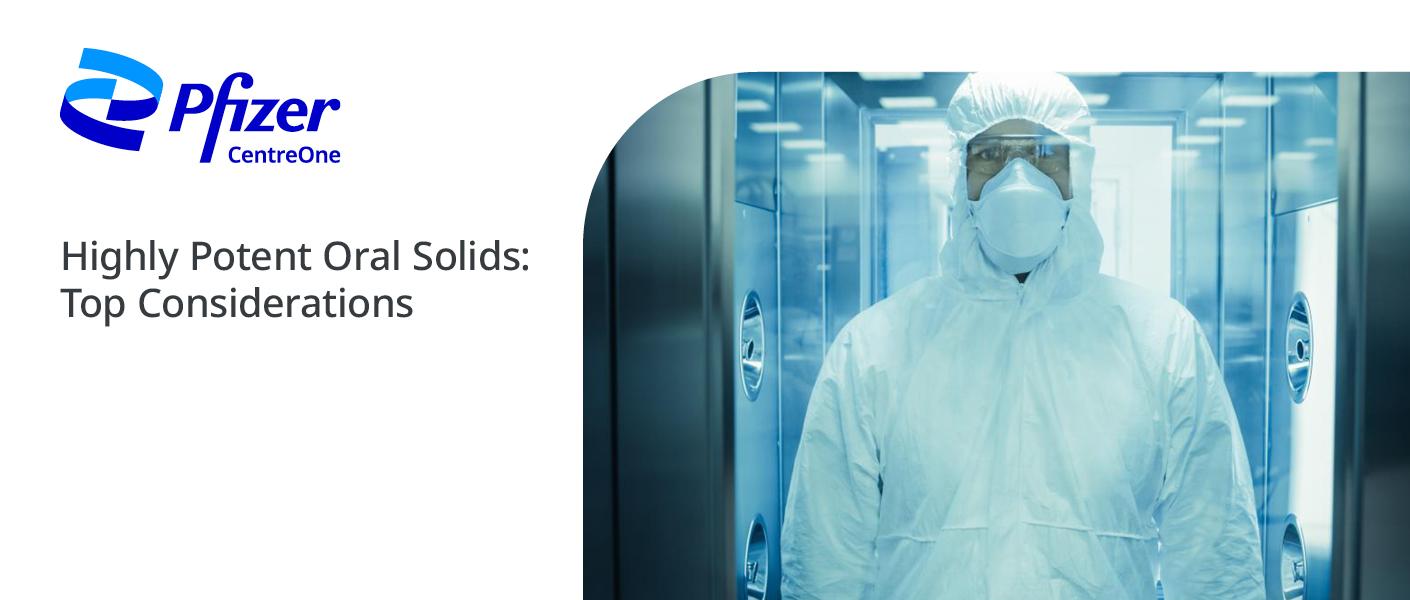
Highly Potent Oral Solids: Top Considerations
Highly potent active pharmaceutical ingredients (HPAPIs) formulated into oral solid dosage forms are used to treat a range of diseases and chronic conditions. According to The Business Research Company, the global HPAPI market is expected to grow from $19.27 billion in 2020 to $20.3 billion in 2021.1
For drug developers and their contract development and manufacturing organization (CDMO) partners, that means addressing challenges stemming from drug product technology transfers. Kieran Coffey, Technical Services Lead at Pfizer CentreOne, discusses these key considerations.
Understand and mitigate HPAPI risk
Understanding product classification and the heightened complexity of HPAPI drug substance transfer and manufacturing is critical. Developers are increasingly working with CDMOs to commercialize their HPAPIs. Research and Markets estimates that the global market for Pharmaceutical Contract Manufacturing reached $100 billion in 2020, and is projected to reach $130.2 billion by 2026.2
It is important to select a CDMO partner adept at taking laboratory developed HPAPI formulations and commercializing them successfully. Managing a HPAPI drug program end-to-end is complex due to the potential impact HPAPIs can have on the environment and worker health and safety.
Addressing HPAPI challenges with partners effectively
Partners must demonstrate fundamental technical capabilities and operational acumen to commercialize, scale, and manufacture HPAPI oral solid drug products compliantly. When selecting partners for a new HPAPI program, drug sponsors must ensure the following three areas are central to the discussion:
-
Classifying the potency of their compound and defining the hazards associated with it.
-
Understanding and defining the overall containment strategy.
- Moving the compound’s formulation from the lab to commercial scale manufacturing.
Classifying potency
There is no standard for the definition of a HPAPI because classification systems vary across regions. High potency actives can generally be defined as one (or more) of the following3:
-
A pharmacologically-active ingredient or intermediate with biological activity at approximately 150 μg/kg of body weight or below in humans (therapeutic daily dose at or below 10 mg);
-
An API or intermediate with an occupational exposure limit (OEL) at or below 10 μg/m3 of air as an 8-hour time-weighted average;
-
Sex hormones and certain other steroids;
-
A pharmacologically-active ingredient or intermediate with high selectivity (i.e., ability to bind to specific receptors or inhibit specific enzymes) and/or with the potential to cause cancer, mutations, developmental defects or reproductive toxicity at low doses; and/or
-
A novel compound of unknown potency and toxicity. (It is important to remember that potency is not the same as toxicity. A drug may be both highly potent and toxic, but this is not necessarily the case.)
The most common classification method relied on by sponsors is the control banding strategy which categorizes APIs based on occupational exposure limits (OELs). Once an OEL is identified, the API is placed into the appropriate occupational exposure band (OEB)3. Typically, OEB systems categorize compounds from low to high potency and define the handling/containment requirements based upon the OEB category.
The importance of containment strategy
A comprehensive containment strategy is key when establishing a new highly potent oral solid dose (HPOSD) production line or upgrading an existing drug’s production line, as it plays an important role during technology transfer.
The first step is to determine if an active ingredient is potentially hazardous to those working with it. For drugs that do not require segregation, a quality risk assessment should be conducted to ensure the technical and organizational controls are in place to prevent cross-contamination.
At Pfizer CentreOne, four levels of containment are in place to manage risk:
- Equipment and controls that come into contact or handle HPAPIs in process.
- Heating, ventilation and air conditioning system inside the facility.
- Facility segregation, which can be broken down into the movement of the people and materials, restricted access of personnel within the facility, segregation of mechanical/electrical from the equipment, and dedicated/segregated utilities.
- Personal protective equipment is used within a specially designed facility.
A well-defined technology transfer
One of the biggest challenges in a HPOSD program is generating an efficient technology transfer. An accurate preliminary strategy is a critical step in anticipating the possible issues in terms of process robustness, equipment classifications, and regulatory and environmental health & safety.
There are two types of technology transfer:
- Primary technology transfer new compound from lab to commercial scale-up and manufacturing facility, where the product is transferred from R&D to the receiving site (i.e., to CDMO).
- Secondary technology transfer where the product, already on the market, is transferred from sending site to receiving site.
If a CDMO is not involved in the R&D process for lab scale, then it should be involved in an intermediate batch scale or pilot scale. At this scale, the product profile must be defined including the equipment train classification in accordance with scale up post-approval change (SUPAC) guidelines. In the case of secondary technology transfers, the product is already on the market, therefore, the process profile, including critical steps and equipment train should have been defined.
Key takeaways
For any HPOSD program, start by defining the potency of the drug substance to understand the level of containment. The right data will help assess the level of containment needed for the product.
Secondly, define in detail the scope of the project. An experienced CMDO will help drive a holistic assessment of the existing process and advise the drug program’s managers on potential risks.
Finally, attention to detail is paramount for a successful technology transfer. At the heart of every successful program is a well-executed technology transfer, and the key to successfully commercializing high-potency, high-performance drugs with contract partners.
References
- https://www.wboc.com/story/44408619/high-potency-apis-industry-growth-i…
- https://www.prnewswire.com/news-releases/global-pharmaceutical-contract…
- Farris, J.P., Ader, A.W. and Ku, R.H. History, implementation and evolution of the pharmaceutical hazard categorization and control system. Chem. Today (Apr. 2006), 24: 5-10.
